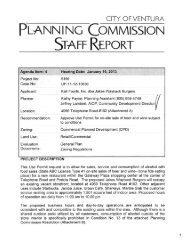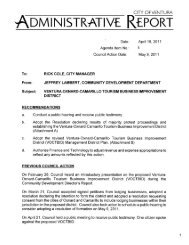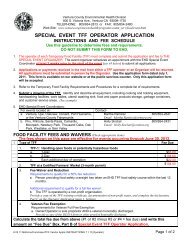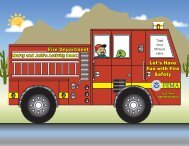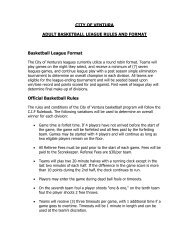Saticoy & Wells Community Plan & Development ... - City Of Ventura
Saticoy & Wells Community Plan & Development ... - City Of Ventura
Saticoy & Wells Community Plan & Development ... - City Of Ventura
Create successful ePaper yourself
Turn your PDF publications into a flip-book with our unique Google optimized e-Paper software.
<strong>Saticoy</strong> & <strong>Wells</strong> <strong>Community</strong> <strong>Plan</strong> and Code EIRSection 4.14 Utilities and Service Systemsb. Drinking Water Quality. The following terms are used to describe water quality:• Maximum Contaminant Level (MCL): The highest level of a contaminant allowed indrinking water. Primary MCLs are set as close to the Federal Public Health Goals orState Maximum Contaminant Level Goals as is economically and technologicallyfeasible. Secondary MCLs are set to protect the odor, taste and appearance ofdrinking water.• Primary Drinking Water Standard: MCLs for contaminants that affect health alongwith their monitoring and reporting requirements, and water treatmentrequirements.• Maximum Contaminant Level Goal: The level of contaminant in drinking waterbelow which there is no known or expected risk to the health; set by EPA.• Public Health Goal: The level of a contaminant in drinking water below which thereis no known or expected risk to health; set by the California EPA.• Regulatory Action Level (RAL): The concentration of a contaminant, which, ifexceeded, triggers treatment or other requirements that a water system must follow.In late 2002, the <strong>City</strong> completed changes to its water supply disinfection program for the use ofchloramines for disinfection rather than chlorine primarily because the Casitas District alsoswitched to chloramine disinfection and the two methods can’t be utilized where the waterwould be commingled. This process was selected because chloramines have less odor and taste.The <strong>City</strong> owns and maintains a full scale, state certified laboratory where water quality ismonitored. All treatment plants are run by State certified operators who consistently monitorwater quality constituents.In order to ensure tap water is safe to drink, the U.S. Environmental Protection Agency (EPA)and the California Department of Health Services prescribe regulations that limit the amount ofcertain contaminants allowed in water provided by public water systems. The <strong>City</strong> of <strong>Ventura</strong>treats its water according to the Department's regulations. Table 4.14-9 shows 2008 waterquality test results for <strong>Ventura</strong>. The system meets all primary drinking water standardsincluding state and federal water quality requirements. However, as shown in Table 4.14-3, theaverage total specific conductance and sulfate from groundwater sources was slightly higherthan the Maximum Contaminant Level (MCL) for secondary standards.The Department of Heath Services also conducts an annual inspection of the public watersystems. Table 4.14-4 shows water quality testing results for the distribution system and wells.The 2008 inspection report does not indicate above average levels for any primary standards.c. Wastewater Collection and Treatment. The <strong>Ventura</strong> Water Reclamation Facility(WRF) is a permitted tertiary treatment plant with a 14 MGD capacity, located at 1400Spinnaker Drive, near the mouth of the Santa Clara River in the <strong>Ventura</strong> Harbor area and treatsthe majority of wastewater generated in the Project Area. Wastewater flows in the Project Areawould be directed to this facility (pers. comm., Don Burt, <strong>City</strong> of <strong>Ventura</strong> Public Works,December 2008). Locations of the <strong>City</strong>’s sewage collecting facilities are shown on Figure 4.14-2.However, portions of the Project Area lie within the unincorporated County and are servedeither by the <strong>Saticoy</strong> Sanitary District or by4.14-5<strong>City</strong> of <strong>Ventura</strong>







